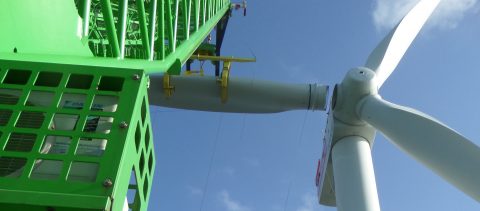
The lifting process on jack-up vessels is a key process in any offshore wind turbine installation or maintenance project. Control systems such as tagline systems are a necessary part of the lifting setup. Their purpose is to help manoeuver loads – such as wind turbine components – to the desired point accurately and safely.
The most obvious source of movement of a hoisted load is due to inertia and wind. Yet the solutions for controlling these motions are subject to other practical constraints that often make it difficult to achieve sufficient control during the lifting process.
Fine crane control difficult to achieve
A lifting operation normally involves three phases: pick-up, hoisting, and installation. These can be performed in reverse order, in the case of disassembly.
Most control systems today are designed with a focus on hoisting and installation, meaning control is best when the load is suspended in the air and positioned in front of and perpendicular to the boom.
During the hoisting phase, fine control is not usually necessary. A basic level of control that keeps the load in a safe orientation is sufficient. But it is a different matter in the pick-up and installation phases.
The installation phase, when the load is near the top of the boom, often involves manoeuvring components into spaces with small clearances. Here, it is essential the load orientation can be finely controlled at all times.
Lifting: Pick-up phase
When considering control systems, the pick-up phase requires a disproportionate amount of engineering time compared to the other two phases because of the geometric constraints
During the pick-up phase, fine control is necessary to avoid collisions with vessel infrastructure and other payload items. However, the geometry of the vessel, crane and taglines can make it difficult to achieve a sufficient level of control. In other words, poor control during pick-up is a consequence of vessel and crane geometry as well as deck layout.
Tagline configuration
In order to provide the maximum possible control, taglines must be carefully configured. First, they should be oriented perpendicular to the axis about which control is required. For example, if control over the load about the vertical axis is required, the taglines should be oriented as closely as possible to horizontal.
Second, the taglines should maintain their optimum orientation throughout the duration of the lift, which will allow control over the entire hoisting range.
Third, the taglines must not clash with the vessel or deck items at any time during the lift.
One of the main difficulties for the pick-up phase is configuring the taglines in the limited space available on the vessel.
Many offshore cranes have high pedestals to achieve greater lifting heights and to provide clearance for items on deck. Maximizing space on deck often means placing items at or near the crane’s minimum radius. These two geometrical givens determine the general position of the taglines, which creates consequences for control and safety.
For tagline systems attached to the boom, the angle of the tagline from the horizontal is determined by the ratio of the height of the tagline above deck (a function of the pedestal/pivot height) and the outreach of the load. Increasing the pedestal height or decreasing the minimum outreach will increase the angle of the tagline relative to the horizontal, which will decrease control close to deck.
Lifting control solutions create problems
There are a several viable solutions for overcoming geometric constraints. However, each solution has certain other implications that need to be considered.
One option is to use deck winches for when the load is close to deck, but winches require significant planning to ensure that they do not hinder slewing operations or clash with other deck items on the vessel. The winches also take up valuable deck real estate. If used in conjunction with boom-mounted systems, the increased complexity increases lifting risk.
Tagline winches can also be routed through the backmast of the crane, gaining horizontal distance from the load. However, from this position, the taglines don’t follow the load as it is hoisted, meaning control during the installation phase is affected.
It is also important to note that this position might not provide a big advantage over a boom-mounted system, and that any improvements to the control gained near deck may be lost during installation.
Choosing the right lifting control solution
To achieve safe and accurate lifting, it is important to design a solution specifically for the project based on detailed planning covering all three phases of the lift. An adaptable setup that can travel the boom while still reaching low enough to allow full control from the deck can offer the best combination of control and practicality, leading to safe and successful lifts.
Like this post? Subscribe now and get notified about new content!





